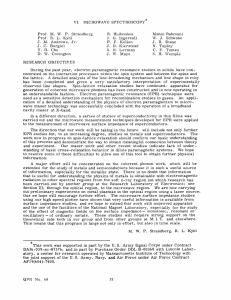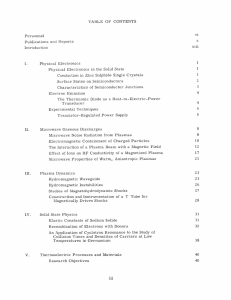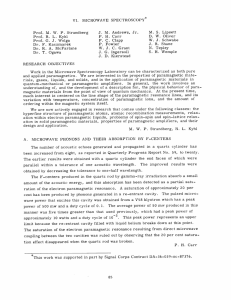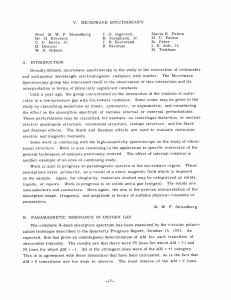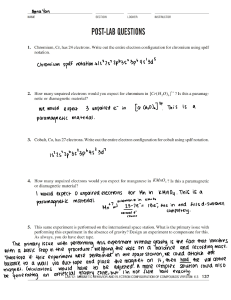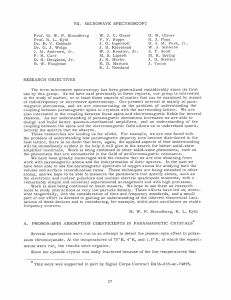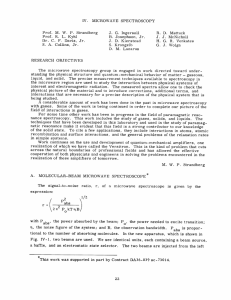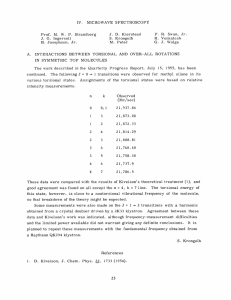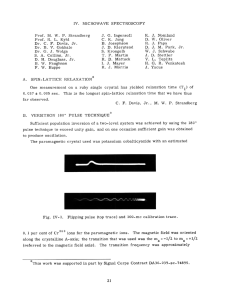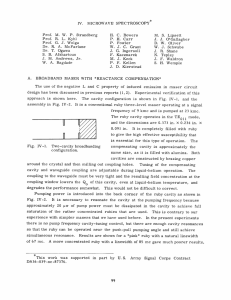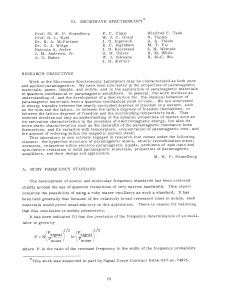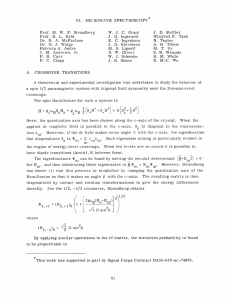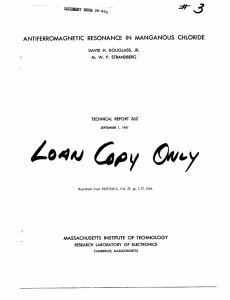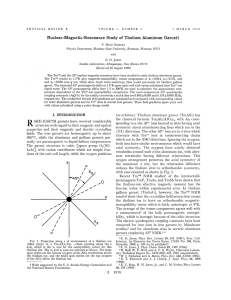V. MICROWAVE SPECTROSCOPY Prof. M. W. P. Strandberg
advertisement
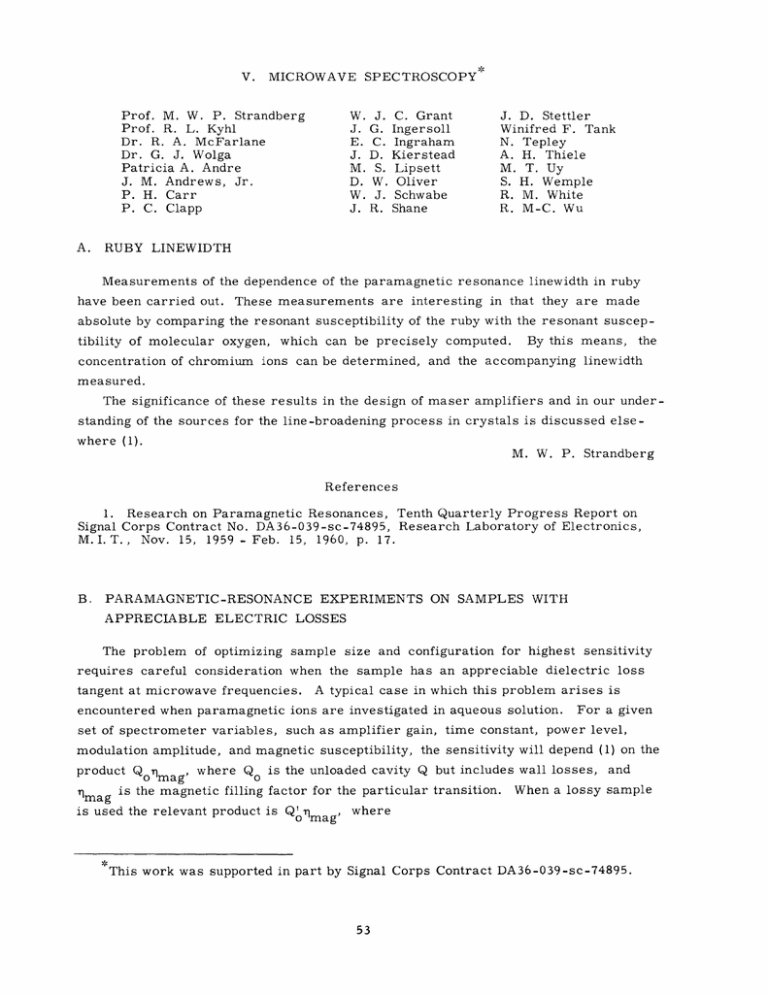
V. MICROWAVE Prof. M. W. P. Strandberg Prof. R. L. Kyhl Dr. R. A. McFarlane Dr. G. J. Wolga Patricia A. Andre J. M. Andrews, Jr. P. H. Carr P. C. Clapp A. W. J. E. J. M. D. W. J. SPECTROSCOPY J. G. C. D. S. W. J. R. C. Grant Ingersoll Ingraham Kierstead Lipsett Oliver Schwabe Shane J. D. Stettler Winifred F. Tank N. Tepley A. H. Thiele M. T. Uy S. H. Wemple R. M. White R. M-C. Wu RUBY LINEWIDTH Measurements of the dependence of the paramagnetic resonance linewidth in ruby have been carried out. These measurements are interesting in that they are made absolute by comparing the resonant susceptibility of the ruby with the resonant susceptibility of molecular oxygen, By this means, which can be precisely computed. concentration of chromium ions can be determined, the and the accompanying linewidth measured. The significance of these results in the design of maser amplifiers and in our understanding of the sources for the line-broadening process in crystals is discussed elsewhere (1). M. W. P. Strandberg References 1. Research on Paramagnetic Resonances, Tenth Quarterly Progress Report on Signal Corps Contract No. DA36-039-sc-74895, Research Laboratory of Electronics, M. I.T., Nov. 15, 1959 - Feb. 15, 1960, p. 17. B. PARAMAGNETIC-RESONANCE EXPERIMENTS ON SAMPLES WITH APPRECIABLE ELECTRIC LOSSES The problem of optimizing sample size and configuration for highest sensitivity requires careful consideration when the sample has an appreciable dielectric loss tangent at microwave frequencies. A typical case in which this problem arises is encountered when paramagnetic ions are investigated in aqueous solution. For a given set of spectrometer variables, such as amplifier gain, time constant, power level, modulation amplitude, and magnetic susceptibility, the sensitivity will depend (1) on the product Qi mag, where Q 1 is the unloaded cavity Q but includes wall losses, mag is the magnetic filling factor for the particular transition. is used the relevant product is Qomag where and When a lossy sample This work was supported in part by Signal Corps Contract DA36-039-sc-74895. (V. MICROWAVE 1 1 Q- Qo + 4 SPEC TROSCOPY) TrXe1 e in which X" is the imaginary part (loss term) of the electric susceptibility, and e the electric filling factor. re is e This product was investigated with particular reference to the types of cavities used in the Microwave Spectroscopy Laboratory (RLE), especially to those used with water samples. The optimum values for volumes of aqueous samples are: 0. 02 cm3 for the cylindrical TE 0 11 cavity; 0. 03 cm 3 for the rectangular TE 10 1 cavity. G. J. Wolga References 1. M. W. P. Strandberg, M. Tinkham, I. H. Solt, Jr., and C. F. Davis, Jr., Recording magnetic-resonance spectrometer, Rev. Sci. Instr. 27, 596-605 (1956). C. GAIN BANDWIDTH IN CIRCUITS WITH NEGATIVE L AND C A network-theory analysis has been made of gain-bandwidth limitations for singlecavity maser amplifiers by making use of the negative inductance and negative capacitance properties (1) of the inverted quantum-mechanical parallels the work of Fano (2) on passive networks. resonance. This analysis In the narrow-band high-gain limit the result is 1 n In G1/2 d - = 1Aw 2f para 1+3fXm mllax wo/ kparaOl 3- 1] where G1/2 represents voltage gain as a function of angular frequency w; Aw para and w0 refer to the natural linewidth and transition frequency of the paramagnetic resonance; Xmax ma is the peak value of the absorptive component of susceptibility; and f is a cavity filling factor. For broadband networks with square bandpass of width Aw, the result can be given in closed form: fX max i o /Aw para =A A+ 3 A3 L+(nIj In G 1/2 where A - / 2 az 1 In G 1/2 A para The analysis is exact only for Lorentz-shaped lines. Full details of the analysis are given elsewhere (3). R. L. Kyhl (V. MICROWAVE SPECTROSCOPY) References No. 1. R. L. Kyhl, Maser circuits with negative L and C, Quarterly Progress Report 56, Research Laboratory of Electronics, M. I. T., Jan. 15, 1960, pp. 83-88. 2. R. M. Fano, Theoretical limitations on the broadband matching of arbitrary impedances, J. Franklin Inst. 249, 57 (January 1950); 139 (February 1950). 3. Research on Paramagnetic Resonances, Tenth Quarterly Progress Report on Signal Corps Contract No. DA36-039-sc-74895, Research Laboratory of Electronics, M. I. T., Nov. 15, 1959 - Feb. 15, 1960, p. 1.
